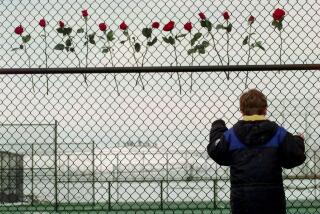Editorial: Rightly or wrongly, Parker Center’s dark history appears to have paved the way for its demise
The history of seemingly every square foot of habitable land on Earth is littered with stories of death, destruction, brutality and injustice. Almost every place where people live today had former occupants who were more than likely forced to leave under unhappy circumstances. In California, we perversely memorialize the land losers by naming new developments after the things that were obliterated to make room for them — orange groves, Spanish ranchos, Indian hills.
So it’s no surprise that there was a dark side to the construction of Parker Center, the shuttered Los Angeles police headquarters whose date with the wrecking ball may soon be set by the City Council.
Back in the 1950s when it was built, this blue box — designed by noted L.A. architect Welton Becket in the then-fashionable international style — was the physical manifestation of the new and enlightened policing philosophy of the day: a professional centralized police force armed with state-of-the-art crime-fighting resources. Since then, the city’s sunny view of the police force and the building that housed it for so many years has been tempered by Parker Center’s mixed history of celebrity, scandal and urban strife.
The city’s Japanese American residents, however, saw the new police building differently then. Many still do. To them, it represents yet another slight to their community. The block on which Parker Center now sits was once a vital part of Little Tokyo. The city seized the land through eminent domain in the late 1940s, at a time when Japanese Americans were still recovering from the forced internment during World War II that cost them their homes and businesses. Several Little Tokyo businesses were displaced to make way for the center’s construction. To make matters worse, the finished building solidified the figurative wall between the halls of power and Little Tokyo. Parker Center faced City Hall to the west and gave its rear to the diminished community.
Demolishing the building is hardly the only way to provide a better gateway to Little Tokyo and reduce the sense of physical isolation.
Resentment still lingers among the children and grandchildren of that generation who remain strongly engaged in the cultural heart of the city’s Japanese American community. Exacerbating the historic pain, the city-owned portion of this stretch of what was once North San Pedro Street (now named for a prominent Japanese American, the late Judge John Aiso) remains a barrier and a blight. On one side with Parker Center are an odd concrete mini park and a razor-wire-topped wall surrounding the back of the Metropolitan Detention Center. On the other is an eyesore of a city parking structure that locals call, not affectionately, the Tinkertoy.
Now that there’s a push to save Parker Center by preservationists (the city’s Cultural Heritage Commission unanimously sought to designate it a City Historic-Cultural Monument), Little Tokyo is pushing back. But it’s not 70-year-old resentment that has Little Tokyo business groups and community activists calling for Parker Center’s demolition — or not only that. They are afraid that, once again, Little Tokyo will get stiffed by City Hall when it comes to developing a key connection to their community and civic center.
In their view, preserving Parker Center means preserving — and worse, implicitly celebrating — the old physical barrier between Little Tokyo and the halls of power. That’s because undertaking a costly preservation effort would make it difficult to fill that spot with a new city office complex that would be open and welcoming to Little Tokyo, plus have a lot of underground parking.
The City Council appears to agree with the Little Tokyo position. On Tuesday, it voted 10-0 to deny the proposed historic-cultural status for Parker Center. This doesn’t automatically summon the bulldozers, but it does indicate the council’s disinterest in preserving the center. And it hints strongly that the council will support a proposed redevelopment plan for that block that includes tearing down Parker Center.
The Japanese American community’s worry about getting the short end of the stick from City Hall is understandable — just ask the supporters of Measure S, an initiative that would rein in the council’s power to bend land-use rules. And so is Little Tokyo’s longstanding grievance against Parker Center. Yet demolishing the building is hardly the only way to provide a better gateway to Little Tokyo and reduce the sense of physical isolation. It’s unfortunate that city officials can’t seem to envision a middle ground that saves this important piece of L.A.’s history without snubbing Little Tokyo again.
Follow the Opinion section on Twitter @latimesopinion and Facebook
More to Read
A cure for the common opinion
Get thought-provoking perspectives with our weekly newsletter.
You may occasionally receive promotional content from the Los Angeles Times.






